Some of the ‘tamest’ magpies I’ve ever seen.
Four days ago on a remote road in northern Utah I found a group of mostly immature Black-billed Magpies that had been feeding on roadkill. I slowed my pickup down to a crawl as I passed so I could identify the roadkill which turned out to be a rabbit.
I’m about to tell you more than you want to know.
At that moment I felt ‘nature calling’ and since I was nearly stopped anyway I got out of my pickup to uh… water the horse. Two big cups of coffee and then milk to wash down my chocolate donut will do that. As I exited my pickup the dead rabbit was about 8′ from me, just below and to the driver’s side of my rear bumper. I hadn’t even closed my door when one of the magpies came from out of nowhere, landed on the rabbit and began to feed as it seemed to completely ignore me even though I was so close I felt I could almost reach out and touch it. That poor bird must have been starving because around here magpies are typically very difficult to get close to.
So you know me, I backed my pickup up to get further away and a better light angle on the rabbit and waited with my lens at the ready for the magpies to begin feeding again. I’ll spare you most of my somewhat grisly photos that include the dead rabbit but I think some of my flight shots are worth seeing.
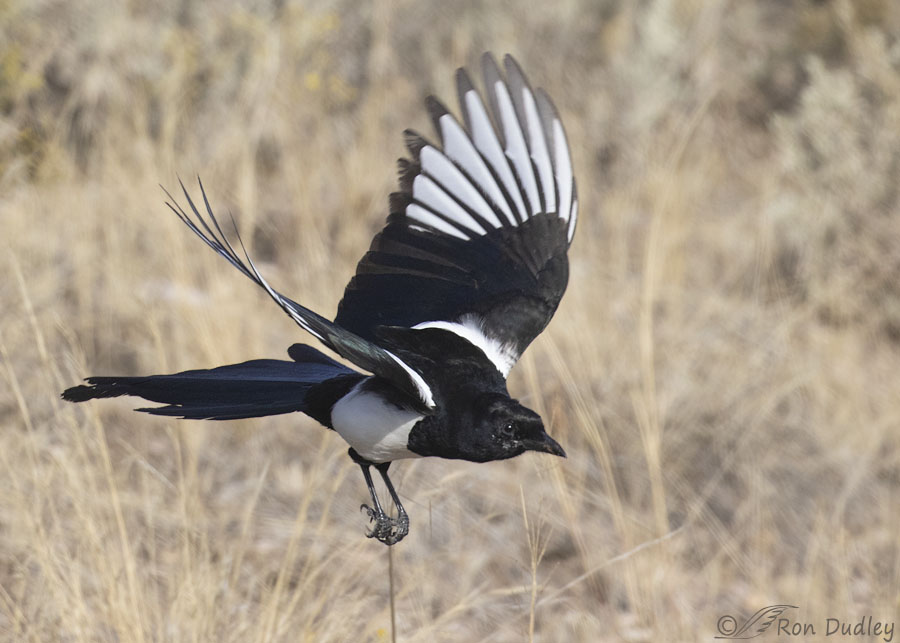
1/2500, f/5.6, ISO 500, Canon 7D, Canon EF 100-400mm f/4.5-5.6L IS II USM @ 330 mm. not baited, set up or called in
Three different magpies flew in mostly at different times to feed on the rabbit.
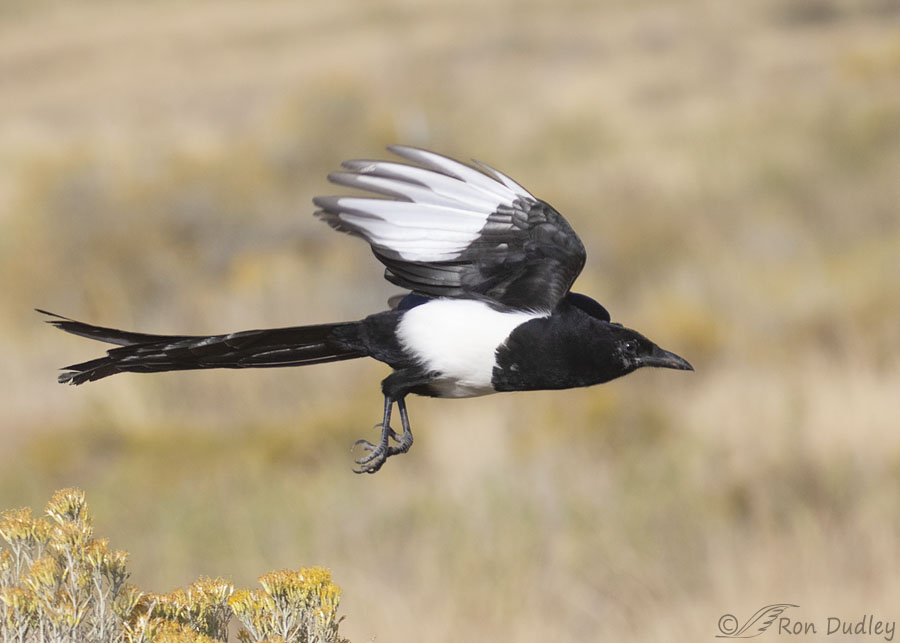
1/3200, f/5, ISO 500, Canon 7D, Canon EF 100-400mm f/4.5-5.6L IS II USM @ 158 mm. not baited, set up or called in
Even after moving further away I was still too close to use my big lens for flight shots so all of these photos were taken with my smaller zoom lens, what I call my ‘baby lens’.
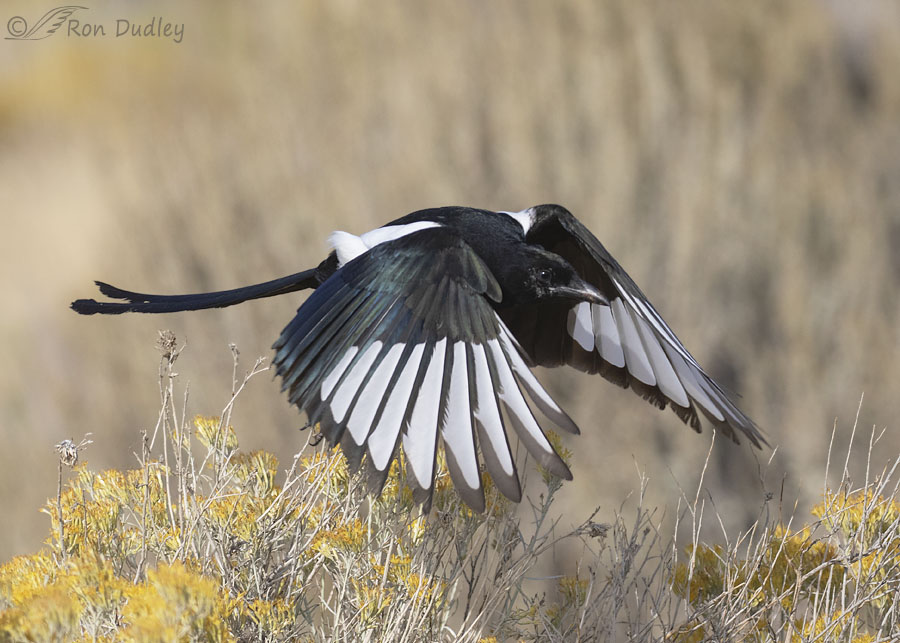
1/2000, f/5, ISO 500, Canon 7D, Canon EF 100-400mm f/4.5-5.6L IS II USM @ 248 mm. not baited, set up or called in
I think this one could have been a pretty darn good shot if I had any detail in the shadows on the left wing behind the head. In fact I like it quite a lot despite that deficiency.
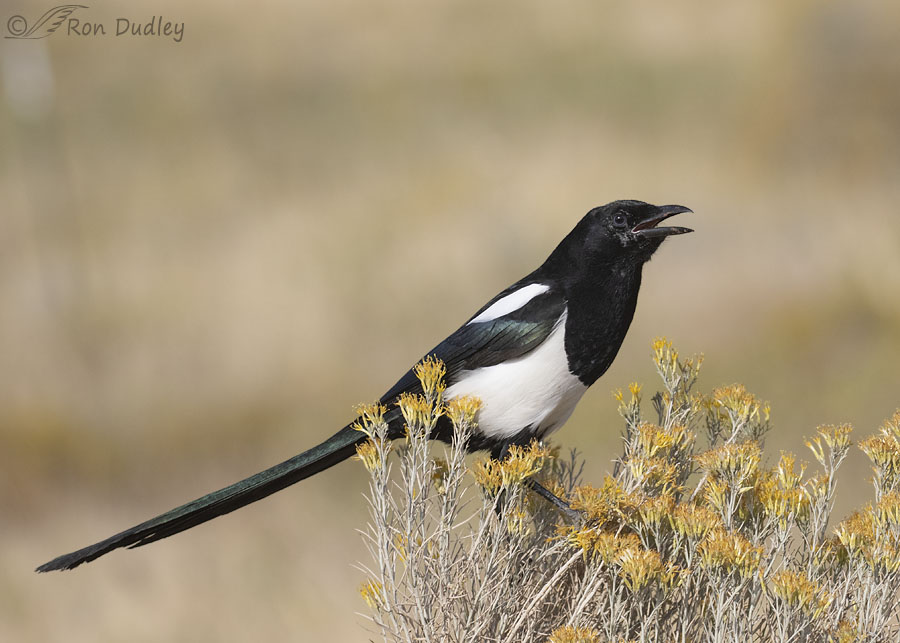
1/3200, f/5, ISO 500, Canon 7D, Canon EF 100-400mm f/4.5-5.6L IS II USM @ 220 mm. not baited, set up or called in
Typically the magpies were landing on nearby blooming rabbitbrush before they flew down to the rabbit. This is one of the few shots I got that showed significant iridescence since most of the magpies were immature and birds of that age show much less iridescence than adults.
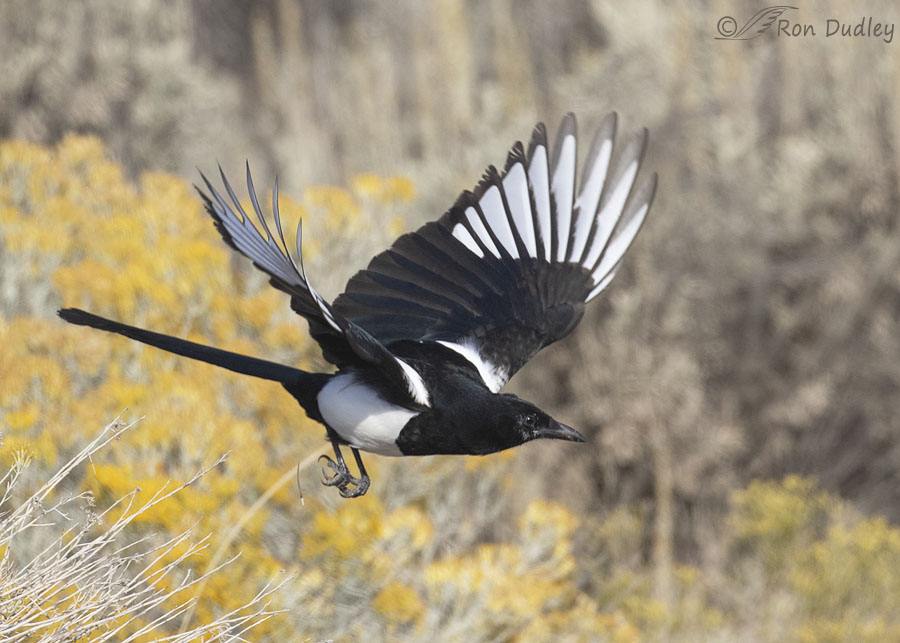
1/2500, f/5.6, ISO 500, Canon 7D, Canon EF 100-400mm f/4.5-5.6L IS II USM @ 330 mm. not baited, set up or called in
The blooming rabbitbrush provided some color in many of my backgrounds. This time of year it’s mostly pretty dry and brown around here.
The last photo below includes the rabbit. Scroll no further if you don’t have the stomach for it.
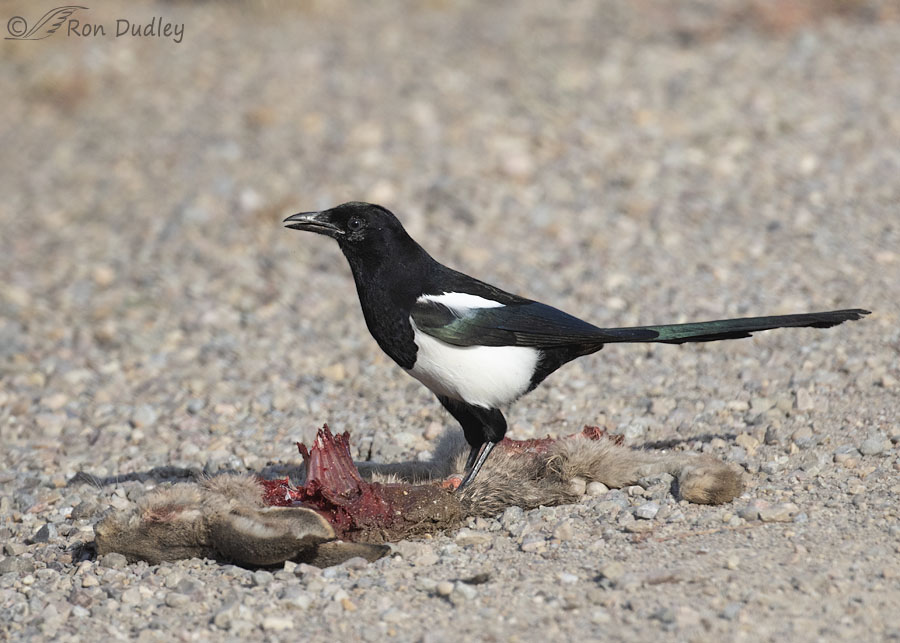
1/3200, f/5.6, ISO 500, Canon 7D, Canon EF 100-400mm f/4.5-5.6L IS II USM @ 340 mm. not baited, set up or called in
That magpie bill was surprisingly efficient at tearing meat off of the rabbit. It seemed to come off easily – maybe the rabbit was more ‘ripe’ than I thought it was, even though there was no noticeable rotten meat smell.
That first magpie when I exited my pickup was the closest I’ve ever been to a magpie. Magpies (and ravens) have been shot as vermin for so many generations they’ve learned as a species to be very wary of humans, especially in remote areas like this. But they haven’t always been that way. When Lewis and Clark first encountered magpies in 1804 in South Dakota these birds were bold, to the point of entering their tents to steal meat and taking food from their hands.
Perhaps these magpies were reverting to their ancestral ways but I think it’s more likely that they were just very, very hungry.
Ron


Love this series,,,such elegant, mischief-making clowns….
Thanks, Patty.
I really miss these guys from my time in Utah and Colorado. Your photos bring back fond memories (with the possible exception of the roadkill🥴). Although one wonders if their numbers have increased due to the automobile.
If we didn’t have them around I’d miss them too.
Poor Bugs, but what a treat watching/shooting the Magpies.
Thank you, Jean.
Hi, Ron – I’ve been in central Washington for about a year and a half now and have had such fun watching the magpies in our yard. We had a lot of babies this year, and watching them grow, play and learn is so interesting. Some were from a nest in one of our spruce trees, and I was introduced to your site by your fabulous post on the Anatomy of a Magpie Nest (8/4/16).
Thanks for the great work you share with us!
Thank you, Carolyn. And welcome to Feathered Photography.
I adore your magpies (and our very different ones) so this series was a complete delight.
Thank you.
Thanks, EC. I saw another video yesterday of one of your Australian Magpies being aggressive to humans.
They can be. Particularly in nesting season and almost exclusively the males. They are also selective. We have magpies close to home and neither my partner nor I have ever been swooped (much less attacked).
I’m a fan of magpies. I like to see them interact with one another.
Good.
I just love this series. The whole darn corvid family ROCKS!! Yeah, they can be annoying at times, but aren’t we all. I suspect you’re right that they were hungrier than they were afraid.
In the more-than-you-EVER-wanted-to-know department, dead stuff (aka hawk food) tends to mummify before it rots, particularly here in the west. But even back in New York, I put a bunny on top of the weathering yard (protected place to perch a hawk outside) and it took several days for the flies to find it. So there’s more than you needed to know–ever 😉
Laura, it’s hard to tell what will happen with road kill. I’ve tried to photograph birds that were near roadkilled skunks and porcupines that smelled so bad I thought I was going to lose my breakfast. Other times there’s been no smell at all. I think in part it depends on the temperature.
Yes, temperature and humidity. Humidity is a biggie!
Beautiful photos! Juvenile magpies have not always had negative experience with humans yet. They also seem to feel safety in greater numbers in the fall. I find them very excepting of my presence. I always feel conflicted about this, I will not harm them and cherish the encounter but the next human they encounter might not be benign. So do I want to encourage the encounter with me? Sadly no. I will interact more with the rehabbed juvenile released at my yard, I still need to monitor their condition and success.
When I meet someone who doesn’t like magpies, I ask them if they like killer whales. Everyone says yes. I tell them magpies are the killer whales of the sky. Magpies are opportunistic feeders, they eat everything including other birds and raid nests. Killer whales are brutal in some of the kills they make to survive. Most people have not seen how they separate baby whales from mothers and eat the young. Now that the sea ice is receding pods of killer whales have been destroying pods of narwhals who traditional are safe in their fjords. Nature is not kind, animals must kill to eat and survive. Humans have the ability to be kind but many lack understanding toward wildlife.
A thought-provoking comment, April. Thank you.
Recently I’ve been seeing reports of killer whales attacking boats in places like Portugal. Here’s an example:
https://www.newsweek.com/killer-whale-attack-yacht-two-hours-1539808
Beautiful shots, Ron…….😀 They are a beautiful bird even if a PITA to me most of the time….😉 We’ve been blessed with few in the yard this year(probably due to the flock of grackles that stayed the summer – also a bit of a PITA) and I recently discovered they won’t mess with Blue Jay’s – have a small flock of them at the moment. 😀
Needed “moisture” last night and this morning and, possibly, for several days – could have just rained but we’ll take what we can get! (snow). 😀
Yeah, I saw your snow on Mike’s post. Snow is still wet, at least eventually.
Beautiful❗️I always appreciate flight shots… how gorgeous are those wings spread out 😁
Thanks, Diana.
Regarding the quote from Cornell, I would argue that because the birds were smarter than the humans, they had to go.
Also, just wanted to share on my never ending animal cognition kick, I’ve many times been victimized by Ravens and Crows who will remove my hot dog or bag of chips from my golf cart and then indulge…They would probably enjoy a chocolate doughnut too. Haven’t seen Magpies do that, but seems like history has.
David, I’m very protective of my chocolate donut when I’m out shooting. Without it I wouldn’t have anything to eat the entire morning until I get home, usually at about noon.
I normally never have any animosity toward birds but a magpie stealing my donut would put me over the edge… 🙂
Serendi-pee-ty at its finest. 😉
Having the bird’s head pop against the dark wing in the 3rd shot makes up for any lack of detail in the shadow for me. And there’s lots of lovely iridescence in the last shot with the bun-bun. So interesting that the majority were immature – I wonder if that has something to do with their ravenous (see what I did there?) behavior.
Hope you eventually got to see a man about a dog. 🙂
Yup, I got the job done, Marty. Not many things take priority over photographing birds but for a few moments that certainly did.
Wonderful photos, Ron. When I see magpies, I always think of you, not because you are similar to a magpie :-), but instead from the amazing photos you have captured of them over the years. Yesterday we were photographing some magpies mixing it up with ravens, the magpies are so photogenic against the deep blue sky of New Mexico.
Thank you for great photos and the interesting information on magpies, Ron.
Thanks very much, Ed. There were ravens hanging around this roadkill too but they never gave me an opportunity to photograph them.
The one on the rabbit bush is gorgeous!
Thank you, Jo.
I loved seeing these birds “up close and personal”—they are among my
most favorite to look at—handsome, contrasty, and even iridescent…it
was interesting to me that you mentioned that younger magpies sport a lesser
degree of iridescence than do the mature ones . Years ago, I was googling
magpie feathers online and found some of your images, which led me to
“Feathered Photography”—-and I’ve been looking and learning ever since.
Thanks !
Kris, I’m very interested to know that you found Feathered Photography through my magpie photos. Quite a few followers found me when they googled Bald Eagles but you’re the first I remember to find me through magpies.
Wonderful flight shots, and you can almost hear the cawing of the one sitting on the rabbitbrush. Thanks!
Yes, that bird on the rabbitbrush was making quite a fuss. Thanks, Cathy.
Great shots!
Please excuse my ignorance, but why were Magpies and Ravens shot as vermin? Because they were a nuisance?
“why were Magpies and Ravens shot as vermin?”
Dick, Here’s what Cornell has to say on the subject:
“Persecuted as “vermin” until mid-twentieth century; to some extent this prejudice lingers among farmers and ranchers. Linsdale (Linsdale 1937) gave vivid accounts of magpies pecking at saddle sores on horses or mules until the animals died, of their propensity to rob traplines, of their taking gamebird or poultry eggs, and of their robbing songbird nests. Magpies can be locally destructive at cherry orchards (Kalmbach 1927). A bounty of $0.01/egg and $0.02/head was paid in many w. U.S. states beginning in the mid-1920s through the 1930s; estimated death toll in Idaho alone was 150,000 magpies. To some extent reputation of magpie was well earned, because of opportunistic nature of their foraging and subsequent cultural transmission (i.e., learned behavior spreading to entire flock) of their rapacious habits.”
OK, thank you for that quote.
In my mind, it just goes to show how lazy and destructive man is in not trying to find an alternative. Now, I have never owned a ranch, or a farm, but songbirds and gamebirds have been here a lot longer than we, and they seemed to survive without our help. Plus, there are plenty of ways to protect poultry from other animals both predators and opportunistic types without harm. Sorry, didn’t mean to sound as though I’m spouting off, but of course I did!
We don’t have Magpies so not familiar with their eating habits. Had no idea they ate flesh. Very interesting. Excellent shots of this beautiful bird. Tough to pick one over another, but I think I will go with the in flight one next to last.
I do remember seeing them in Taos NM and they were very difficult to get close to.
“Had no idea they ate flesh”
Everett, carrion is a big part of their diet although they also eat arthropods and seeds.